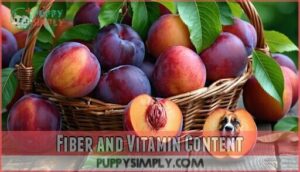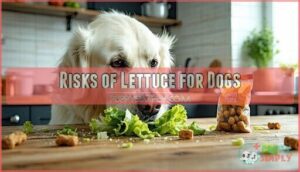This site is supported by our readers. We may earn a commission, at no cost to you, if you purchase through links.
 Yes, dogs can eat lettuce safely! Most varieties like romaine, iceberg, and arugula are perfectly fine for your pup. This leafy green is 90% water, making it a low-calorie treat that won’t pack on pounds.
Yes, dogs can eat lettuce safely! Most varieties like romaine, iceberg, and arugula are perfectly fine for your pup. This leafy green is 90% water, making it a low-calorie treat that won’t pack on pounds.
You’ll want to wash it thoroughly and chop it into bite-sized pieces to prevent choking. While lettuce won’t transform your dog’s health, it offers decent hydration and fiber.
Think of it as nature’s crunchy water bottle with a nutritional bonus. Just don’t go overboard—too much can cause stomach upset or diarrhea. The key is moderation and proper preparation.
Your dog’s regular food should remain the star of the show, with lettuce playing a supporting role as an occasional snack or training reward. There are specific preparation methods and serving sizes that’ll keep your furry friend happy and healthy.
Table Of Contents
- Key Takeaways
- Can Dogs Eat Lettuce
- Is Lettuce Safe for Dogs
- Lettuce Nutritional Value
- Risks of Lettuce for Dogs
- Feeding Lettuce to Dogs
- Lettuce in Dog Diet
- Frequently Asked Questions (FAQs)
- Can dogs eat lettuce?
- Can dogs eat romaine lettuce?
- Can dogs eat iceberg lettuce?
- Can dogs eat butter lettuce?
- Can dogs eat salad?
- Can lettuce help a dog lose weight?
- How much lettuce to give a dog?
- What happens if my dog eats a piece of lettuce?
- Can lettuce upset my dog’s stomach?
- Can puppies eat lettuce safely?
- Conclusion
Key Takeaways
- You can safely feed your dog lettuce – romaine, iceberg, and arugula are all non-toxic options that provide hydration and fiber as occasional treats
- Proper preparation is essential – you’ll need to wash lettuce thoroughly and chop it into bite-sized pieces to prevent choking and remove harmful bacteria
- Moderation prevents digestive issues – too much lettuce can cause diarrhea and stomach upset, so stick to small portions based on your dog’s size
- It’s a perfect low-calorie training treat – with 90% water content and only 10 calories per cup, lettuce won’t add pounds while keeping your pup hydrated
Can Dogs Eat Lettuce
You’re probably wondering if it’s safe to share your leafy greens with your furry friend, and the good news is that most lettuce varieties are perfectly fine for dogs to eat.
Romaine, iceberg, and arugula lettuce can all be safely given to your dog when properly prepared and served in moderation.
The key point to remember is that your dog should only eat lettuce that has been properly prepared.
Safe Lettuce Types for Dogs
Most lettuce varieties are safe for dogs, but some offer better benefits than others.
Romaine safety stands out with its beta-carotene content, while arugula benefits include fiber and vitamins.
Iceberg concerns center on low nutritional value despite being non-toxic.
Organic lettuce reduces pesticide exposure.
Mixed greens like butterhead and leaf lettuce work well too.
Lettuce offers hydration because it’s 90% water.
Can dogs eat lettuce? Yes, these dog safe vegetables make healthy treats when chosen wisely.
Preparation Methods for Dogs
Proper preparation transforms lettuce for dogs into a safe, digestible treat. You’ll want to master these washing techniques and chopping methods for superior results.
- Thorough washing removes harmful bacteria like E. coli and listeria that could make your furry friend sick
- Small, bite-sized pieces prevent choking hazards and make digestion easier for your dog’s stomach
- Plain serving without dressings or additives keeps this dog-friendly green completely safe and healthy
- Fresh preparation each time guarantees your pup gets the cleanest, safest vegetables for dogs possible
To find the right dog lettuce products, check out the website.
Nutritional Benefits of Lettuce
Beyond proper washing and chopping, lettuce offers surprising nutritional value for your dog.
This leafy green serves as an excellent hydration source, containing 90% water while delivering essential vitamins and minerals.
The fiber benefits support healthy digestion, while Vitamin A promotes good vision.
For weight management, lettuce provides low-calorie satisfaction, and chlorophyll effects may even freshen your pup’s breath naturally.
Is Lettuce Safe for Dogs
Your dog can safely enjoy lettuce as an occasional treat when prepared properly.
Most lettuce varieties pose no lettuce toxicity dogs concerns, making them safe human food for dogs.
However, lettuce allergies can occur in some pets, though they’re rare.
Breed sensitivity doesn’t typically affect lettuce tolerance, but smaller breeds may have more difficulty with dog digestion of large pieces.
Puppy consumption should be limited and supervised, as young digestive systems are more sensitive.
Organic lettuce offers the same benefits with fewer pesticide concerns.
You don’t need to worry about cooking lettuce – raw is perfectly fine and retains more nutrients.
So is lettuce ok for dogs? Absolutely, when given in moderation.
The lettuce benefits for dogs include hydration and fiber, but individual reactions vary.
Start with small amounts to monitor your pet’s response, especially if they’ve sensitive stomachs or food sensitivities.
Lettuce Nutritional Value
When you’re considering lettuce as a treat for your dog, understanding its nutritional profile helps you make informed decisions about this leafy green.
While lettuce won’t replace your dog’s regular food, it offers some surprising benefits that make it worth considering as an occasional snack.
Hydration and Low-Calorie Content
Your pup’s hydration needs just got easier with lettuce’s impressive 96% water content.
Keep your dog hydrated and happy with lettuce’s natural 96% water boost.
This low-calorie powerhouse delivers hydration benefits without adding pounds to your dog’s waistline. At just 10 calories per cup, lettuce makes perfect low-calorie treats for weight management.
The high water content helps dogs feel full while supporting their balanced diet goals naturally. Considering the high water vegetables, lettuce is a great choice, with its low-calorie and high water content making it an ideal snack for weight management.
Fiber and Vitamin Content
Adding roughage to your dog’s diet, lettuce delivers essential fiber and vitamins that support healthy digestion.
This leafy green contains moderate amounts of vitamins K, A, C, and folate, making it a nutritious addition to your pup’s treat rotation.
- Fiber Benefits: Supports regular bowel movements and gut health
- Vitamin Sources: Provides K for blood clotting, A for vision, C for immunity
- Nutrient Absorption: Low-calorie option that won’t interfere with main meals
- Digestion Support: Gentle fiber aids digestive regularity without upset
- Balanced Nutrition: Complements dog safe vegetables in moderation
Beta-Carotene and Vitamin a Benefits
Romaine lettuce packs betacarotene, a powerful antioxidant your dog’s body converts to vitamin A.
This nutrient supports vision support and immune function while promoting healthy growth in puppies.
The antioxidant effects protect cellular health from damage, making romaine one of the best dog safe vegetables.
With proper dog nutrition tips, you’ll harness these benefits safely.
Risks of Lettuce for Dogs
Lettuce is usually safe for dogs, but you should watch out for a few risks like stomach upset, choking, or contaminated greens.
If you know what to avoid, you’ll keep your pup safe and healthy.
Excessive Consumption and Diarrhea
While lettuce offers nutritional benefits, overfeeding can quickly turn this healthy treat into a digestive nightmare for your furry friend.
Too much lettuce can transform your dog’s healthy snack into a digestive disaster.
Too much lettuce overwhelms dogs’ systems, leading to uncomfortable symptoms that’ll have both you and your pup feeling miserable.
- Fiber Overload: Excessive lettuce disrupts your dog’s gut microbiome, causing loose stools and gas
- Dehydration Risk: Persistent diarrhea from overconsumption can lead to fluid loss requiring veterinary attention
- Sensitive Stomachs: Dogs with delicate digestive systems react more severely to lettuce overindulgence
- Breed Sensitivity: Smaller breeds face higher risks of digestive upset from even moderate lettuce portions
Contaminated Lettuce and Bacteria
Beyond digestive upset, unwashed lettuce poses serious bacterial contamination risks.
E coli, Listeria, and Salmonella can lurk on leafy greens, causing severe pet food contamination incidents.
Washing produce thoroughly removes most pesticide concerns and dangerous bacterial strains.
| Contamination Risk | Prevention Method |
|---|---|
| E. coli from irrigation water | Thorough washing under running water |
| Listeria from processing facilities | Choose organic options when possible |
| Pesticide residues on leaves | Proper safe handling and storage |
Always prioritize washing importance – even organic options need cleaning.
Your dog’s health depends on these simple safety steps.
Choking Hazards and Digestive Issues
While most dogs handle lettuce digestion well, choking hazards emerge when you don’t consider piece size and breed differences.
Large chunks can block airways, especially in smaller dogs who gulp their food. Even properly sized pieces may cause stomach upset in dogs with sensitive stomachs.
The fiber content, though beneficial, can trigger gastric issues if your dog isn’t used to it. Goitrogenic compounds in some vegetables can interfere with thyroid function.
Cooking lettuce slightly softens the texture, reducing choking risks while maintaining nutritional benefits for cautious pet parents, which can help prevent stomach upset.
Feeding Lettuce to Dogs
Now that you know lettuce can be a safe treat for your dog, you’ll want to understand proper serving sizes and feeding guidelines.
Getting the right amount matters for your pet’s health and prevents digestive upset.
Safe Quantities and Serving Sizes
Getting the right portion control for your dog’s lettuce treats prevents digestive issues while maximizing benefits.
Size matters when determining daily limits and serving frequency for ideal dog digestive health.
- Extra-small dogs (2-10 lbs): 1-2 small pieces as occasional treat alternatives
- Small dogs (11-20 lbs): Under 1/4 cup chopped lettuce per serving
- Medium dogs (21-50 lbs): Up to 1/2 cup chopped lettuce maximum
- Large dogs (51+ lbs): 3/4 to 1 cup chopped lettuce for biggest breeds
Remember that puppy portions should be even smaller, and all lettuce treats shouldn’t exceed 10% of your dog’s total daily calories to maintain proper dog dietary needs.
Considering the recommended serving size is essential for canine health.
Veterinary Consultation and Guidance
Before making dietary changes, consult your veterinarian for personalized veterinary advice.
PangoVet and online vet consultation services can help assess breed sensitivity and allergy monitoring needs.
Your vet will provide veterinary nutrition guidance on portion control, especially if your dog has prescription conflicts or health conditions requiring specialized diets.
Introducing spinach requires awareness of oxalic acid risks, which is crucial for your dog’s health and allergy monitoring needs.
Lettuce in Dog Diet
You can safely include lettuce in your dog’s diet as a low-calorie treat that supports weight management and hydration.
Just remember to offer it in moderation and make certain your pet still gets a balanced, nutrient-rich diet.
Low-Calorie Training Treats and Snacks
Your dog can enjoy lettuce as a fantastic low-calorie training treat that won’t pack on pounds.
This crunchy snack works perfectly for positive reinforcement while keeping calories in check. Smart portion control makes lettuce an ideal hydration source during training sessions.
- Training benefits: Use small lettuce pieces as frequent rewards without guilt – they’re practically calorie-free
- Treat timing: Perfect for extended training sessions when you need lots of rewards but want to avoid overfeeding
- Lettuce treat alternatives: Mix with other low-calorie options like cucumber or carrots for variety during practice
Considering the importance of low-calorie treat options is essential for maintaining a healthy weight.
Balanced Diet and Nutrient-Dense Foods
Balance serves as the cornerstone of canine nutrition, making lettuce just one piece of your dog’s dietary puzzle.
While lettuce offers hydration and fiber, complete nutrition requires nutrient-dense foods that provide essential proteins, fats, and vitamins.
Your dog’s diet should emphasize food variety through high-quality kibble, lean proteins, and carefully selected vegetables.
Portion control guarantees lettuce supplements rather than replaces nutritionally complete meals, supporting your canine’s dietary needs effectively, ensuring a healthy balance.
Moderation and Avoiding Overconsumption
Remember that even healthy treats like lettuce require portion control to prevent digestive discomfort.
Too much lettuce can cause nutrient displacement in your dog’s balanced diet.
Individual sensitivities vary, so monitor your pet’s reaction when introducing new treats, as moderation keeps lettuce as a beneficial addition to your dog’s dietary habits without compromising their overall health.
Frequently Asked Questions (FAQs)
Can dogs eat lettuce?
Your furry friend can safely munch on lettuce like romaine, iceberg, and arugula. Just wash it thoroughly, chop into small pieces, and serve plain—no dressing allowed!
Can dogs eat romaine lettuce?
Yes, romaine lettuce is safe for your dog to eat.
Wash it thoroughly and chop into small pieces to prevent choking and aid digestion.
Offer it as an occasional low-calorie treat in moderation.
Can dogs eat iceberg lettuce?
Iceberg lettuce is safe for your dog to eat in small amounts. It’s 90% water, making it a hydrating, low-calorie treat. Always wash thoroughly and chop into bite-sized pieces before serving.
Can dogs eat butter lettuce?
Picture your pup’s tail wagging as they crunch into crisp, invigorating greens.
You can safely give your dog butter lettuce! Just wash it thoroughly, chop into small pieces, and offer in moderation as a hydrating, low-calorie treat.
Can dogs eat salad?
Your dog can eat plain lettuce from salads, but avoid dressings, onions, garlic, and other toxic toppings.
Wash thoroughly, chop into small pieces, and offer only as an occasional treat in moderation.
Can lettuce help a dog lose weight?
Lettuce’s high water content and low calories make it an excellent weight-loss treat for dogs. You’ll find it fills them up without adding pounds, especially when replacing higher-calorie snacks.
How much lettuce to give a dog?
Around 90% of lettuce is water, making it nature’s hydrating snack for your furry friend.
You’ll want to give small amounts based on your dog’s size – start with 1/4 cup for small dogs, scaling up to 2 cups for larger breeds daily, as it is a hydrating snack.
What happens if my dog eats a piece of lettuce?
If your dog eats lettuce, it’s typically fine.
Most dogs digest it without issues since lettuce is non-toxic and safe.
You might notice slightly softer stools due to the fiber content, but no serious problems should occur.
Can lettuce upset my dog’s stomach?
Certainly, consuming considerable quantities can cause digestive distress in dogs. You’ll typically see diarrhea or upset stomach if your pup eats too much lettuce at once.
Can puppies eat lettuce safely?
Yes, puppies can safely eat lettuce in moderation with veterinary consultation. Start with small amounts of washed, chopped lettuce to monitor for adverse reactions, especially in sensitive digestive systems.
Conclusion
Absolutely can dogs eat lettuce – it’s practically the ultimate guilt-free snack that’ll make your wallet and your pup’s waistline happy.
This leafy green offers safe hydration and fiber when prepared correctly.
Wash thoroughly, chop into small pieces, and serve in moderation to avoid digestive upset.
Remember that lettuce shouldn’t replace your dog’s balanced diet but works perfectly as an occasional treat or training reward.
When in doubt, consult your veterinarian for personalized feeding guidance.
- https://www.purina.com/articles/dog/feeding/can-dogs-eat/lettuce
- https://www.dogster.com/dog-nutrition/can-dogs-eat-lettuce
- https://www.dialavet.com/blog/can-dogs-eat-lettuce
- https://www.nextritionpet.com/blogs/nutrition/can-dogs-eat-lettuce
- https://wildearth.com/blogs/dog-knowledge/can-dogs-eat-lettuce














